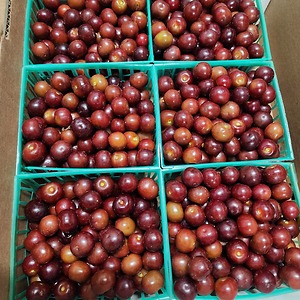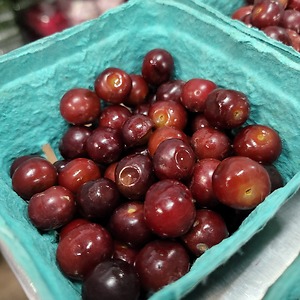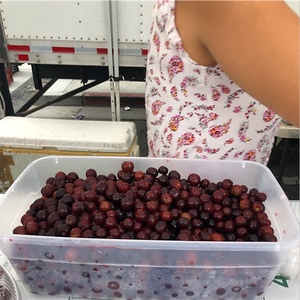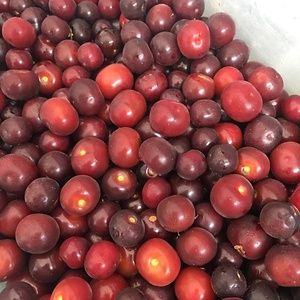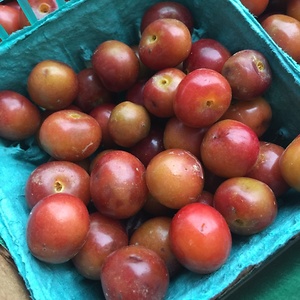


Capulin Cherries
Estimated Inventory, bskt : 0
Description/Taste
Capulin cherries are small in size, averaging 1 to 3 centimeters in diameter, and have a round to ovate shape with curved, uniform edges. The fruit's skin is thin, smooth, glossy, and delicate, showcasing bright red, red-green to maroon, almost black hues. Underneath the surface, the variegated flesh is found in shades of pale green, red to golden yellow and has a firm, aqueous, and crisp, succulent consistency. The flesh also encases a sizeable central pit that holds a bitter kernel. Capulin cherries are unpalatable when unripe and must be fully mature before they carry a sweeter flavor. Ripe Capulin cherries typically darken in color and have a subtly sweet-tart, sometimes astringent taste with a bitter finish, depending on the variety.
Seasons/Availability
Capulin cherries are available in the late spring through summer.
Current Facts
Capulin cherries, botanically classified as Prunus salicifolia, are sweet-tart fruits belonging to the Rosaceae family. The small fruits develop in loose clusters of 15 to 20 cherries and grow on semi-deciduous trees reaching 12 to 15 meters in height. Capulin cherries are known by several regional names, including Capulin, Deste, Mexican Bird cherry, Capoli, Capuli, Capolin, Cerezo Criollo, and Tropic cherry. The trees are favored for their prolific nature and ability to produce fruits when the trees are only 2 to 3 years of age. The trees can also bear more than one crop per season. Despite their productive reputation, Capulin cherries have remained localized to markets in their growing regions in Central and South America and are only available for a short time. The fruit trees are grown on a small scale commercially but are primarily found in the wild or planted in home gardens. There are many varieties of Capulin cherries, with some of the more well-known types being Huachi Grande, Fausto, Werner, Ecuadorian, Harriet, and Lomeli. Capulin cherries are popularly consumed fresh or cooked and are also incorporated into various seasonal beverages.
Nutritional Value
Capulin cherries are a source of vitamin C to strengthen the immune system, boost collagen production, and reduce inflammation. The cherries also provide fiber to regulate the digestive tract, vitamin A to maintain healthy organ functioning, calcium to build strong bones and teeth, and other nutrients, including phosphorus, zinc, vitamin E, iron, niacin, and riboflavin. In natural medicines, Capulin cherries are infused into syrups to help soothe coughs and other respiratory issues. The roots and leaves are cooked and mixed with honey to calm digestive turmoil, and the leaves are also applied topically as a poultice for skin irritations and inflammation.
Applications
Capulin cherries have a sweet-tart, sometimes astringent flavor suited for fresh and cooked preparations. The fruits can be consumed straight out of hand, discarding the pit, or they can be halved, pitted, and tossed into salads, yogurt, fruit bowls, or blended into milkshakes. Capulin cherries are most popularly cooked with sweeteners to create jams, jellies, and syrups. They can also be stewed, simmered into sauces, or used as a filling for tamales. In Mexico, the cherries are sometimes cooked with heavy cream, cinnamon, and vanilla to create a sweet-tart dessert. Capulin cherries can generally be used in recipes calling for sour cherries. The fruits are baked into pies, cakes, and other desserts or infused into chocolate for depth of flavor. Capulin cherries can also be preserved whole for extended use or fermented into alcoholic beverages. Capulin cherries pair well with sweet and savory dishes and can complement appetizers, main dishes, or desserts. Whole, unwashed fruits should be immediately consumed for the best quality and flavor. They will also keep for a few days when stored in a perforated plastic bag in the refrigerator.
Ethnic/Cultural Info
Capulin cherries are an ancient fruit deeply intertwined within the cultural, medicinal, and culinary traditions of native populations throughout Mexico. Beyond its use as a food source, Capulin cherries are sometimes used in amulets worn on the body as protection from evil forces in the Mexican state of Hidalgo. Parts of the tree are also interwoven into floral arrangements. Seeds from the fruit are pressed and processed for their oils, later incorporated into various soaps and paints. The tree's wood is also favored as a construction material for cabinets, furniture, and small figurines.
Geography/History
Capulin cherries are believed by experts to be native to Guatemala and were naturalized throughout Central and South America in ancient times. The trees thrive in subtropical to semi-temperate climates and are popularly planted in backyard landscapes or used as rootstock to plant northern cherry varieties, especially in Guatemala. Capulin cherry trees are also cultivated on a small scale and sold in local markets throughout Central and South America. The fruits are most commonly found in the states of Puebla, Jalisco, Sonora, Veracruz, and Chiapas in Mexico, Peru, El Salvador, Ecuador, Bolivia, and Colombia. Outside of Central and South America, Capulin cherries are very rare. The fruits are sometimes grown in California, having been introduced into the state sometime in the early 19th century and planted in the Philippines in the early 20th century.
Podcast



